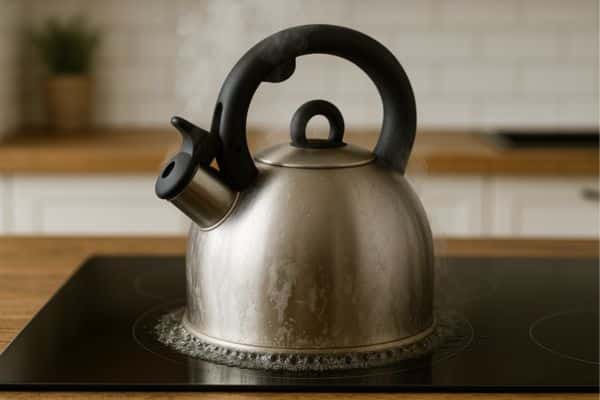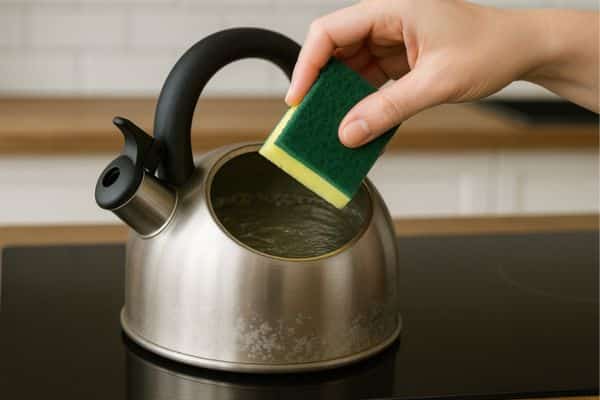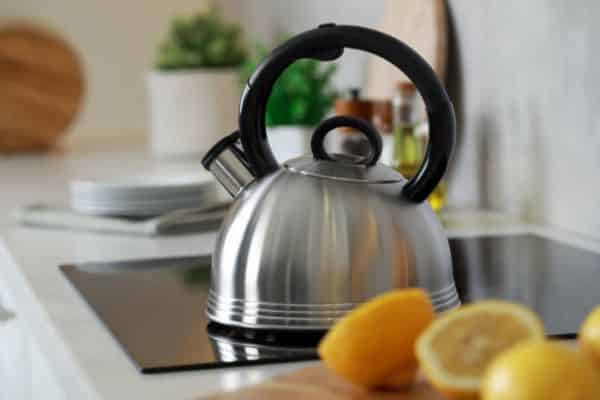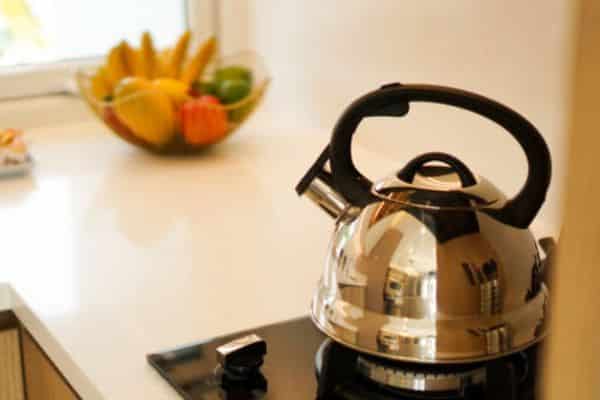I love my morning tea. It’s quiet, warm, and helps me start the day with a calm mind. But one day, I poured my usual cup and saw white bits floating in it. My first thought? Something’s wrong with my kettle. I looked inside. The bottom had a rough, chalky layer. That’s called scale. It builds up over time from minerals in the water. It made my tea taste dull. Made my kettle look old. That’s when I learned how to remove scale from tea kettle the easy way. I didn’t need any fancy tools. Just some basics from the kitchen and a little time.In this guide, I’ll show you
What Causes Scale to Build Up in a Kettle?
Let’s talk about that white stuff at the bottom of your kettle. That’s scale. It shows up from minerals in tap water, mainly calcium and magnesium. These stay behind after the water boils.
In some homes, water has more minerals. This is called hard water. It’s safe to drink, but tough on kettles. Each boil adds a little more buildup. Over time, it forms a crust that sticks.
Scales do more than just look odd. They dull the taste of your tea and slow down heating. Want better results? Try a clean, safe option like the Best Non Toxic Electric Tea Kettle—it keeps water pure and boils fast without the buildup
Step-by-Step Guide
Ready to bring your kettle back to life? You don’t need a special cleaner. You only need a few things you likely already have. This simple process shows how to remove scale from tea kettle without stress. Some call it how to descale a kettle—but it’s really just a quick clean with common stuff.
What You’ll Need:
- White vinegar (or lemon juice)
- Water
- A soft sponge or cloth
- A clean sink
Boil the Descaling Solution

Fill your kettle halfway with equal parts water and vinegar. Turn the heat on and bring it to a boil. Let it bubble for about 5 minutes, then turn it off.
02. Let It Soak
Keep the lid closed. Let the warm mix sit in the kettle for 15–30 minutes. This gives the vinegar or lemon time to loosen the scale. You’ll notice flakes start to break away from the metal.
03. Scrub Gently

Once it cools, pour out the mix. Use a soft sponge to wipe the inside. Most of the scale will come off with little effort.
04. Rinse Well
Fill the kettle with clean water. Boil it, then dump it out. Do this one more time to clear out any taste or smell.
Natural Cleaning Alternatives
Not a fan of vinegar? No problem. There are other ways to clean your kettle that work just as well—some even smell nicer. Let’s look at a few natural choices that are easy, safe, and gentle on your kettle.
Lemon Juice Method

Lemon does more than brighten up your water—it can clean your kettle too. It works well for light buildup and leaves a fresh scent behind.
How to use it:
- Squeeze fresh lemon juice into your pot (about half a cup).
- Add an equal amount of water.
- Bring it to a boil, then let it sit for 15 minutes.
- Pour it out and give the inside a gentle scrub.
- Rinse well with clean water.
Baking Soda Method
Baking soda is great for mild scale and light stains. It’s soft on surfaces and doesn’t leave strong smells.
How to use it:
- Fill the pot with water.
Add one tablespoon of baking soda. - Boil the mix and let it sit for 20 minutes.
- Scrub with a soft cloth and rinse it clean.
Commercial Descaler
For heavy-scale or electric kettles with hidden elements, a store-bought descaler might be best. Just make sure it’s food-safe and follow the directions.
When to use them:
- The scale won’t come off with natural methods
- You need a deep clean
- You want a fast, strong solution
Always rinse well after using any chemical cleaner.
Tips to Prevent Scale in the Future

Once your kettle is clean, the next step is keeping it that way. Good news—it doesn’t take much. A few small habits can make a big difference. You’ll get better-tasting tea and avoid the hassle of deep cleaning later.
Use Filtered Water
Hard water has more minerals. That means more scale. A simple water filter removes a lot of those minerals before they reach your kettle.
Empty After Each Use
Don’t let water sit in the kettle. It gives minerals time to settle and stick. Pour out any leftover water and leave the lid open to let it dry.
Clean Every 10 Uses (Or Monthly)
You don’t need to clean your kettle every day. Just a quick rinse and scrub every 10 uses keeps scale away. For most people, once a month is enough.
Descale Before It Gets Bad
Don’t wait until the bottom turns white. Light cleaning is faster and easier than deep scrubbing. If you see a thin film, that’s your sign to descale.
Electric Kettles vs. Stove-Top Kettles: Any Difference?
Both types heat water. But how they’re built means you may need to treat them a little differently. The good news? The goal stays the same—a clean pot and better-tasting tea.
Electric Kettles
These are fast, easy, and common in many homes. Most have a heating element inside or under the base. That element is where scale loves to hide.
Cleaning tips:
- Never put the base in water
- Don’t submerge the kettle
- Pour in the cleaning mix and let it sit just like with a stove-top
- Rinse carefully, so no water reaches the wiring
Stove-Top Kettles
These are simple and tough. You heat them on the stove, and there’s no wiring inside. That means you can rinse and scrub more freely.
Cleaning tips:
- Use any natural method—lemon, vinegar, or baking soda
- Soak and scrub as needed
- Dry fully after each use
In short, both pot types can build scale in the same way. The only difference is how you handle them while cleaning. Just take a little extra care with electric ones, and both will give you hot water that’s clean, fast, and scale-free.
Common Mistakes to Avoid
Cleaning your kettle is easy, but there are a few things that can go wrong. These simple missteps can damage or mess with the taste of your tea. Let’s make sure you skip them.
Scrubbing Too Hard
It’s tempting to scrape off the scale fast. But rough scrubbing can scratch the inside. This is especially true for electric kettles with coated surfaces.
Using Harsh Chemicals
Bleach, drain cleaner, or strong sprays may seem like a good idea. But they’re unsafe for things that hold water, you drink. Even small traces can affect your health.
Forgetting to Rinse Well
A great clean means nothing if the rinse is skipped. Vinegar or lemon left behind can change how your tea tastes—and not in a good way.
Final Thoughts
A clean kettle is a happy kettle. And more than that—it’s the key to a perfect cup of tea. A little buildup may not seem like much at first, but over time, it changes everything. The taste, the boil time, even the way your pot looks.
The good news? You don’t need anything fancy. Just a bit of vinegar, lemon, or baking soda does the trick. Do it once a month, and your kettle will thank you—and so will your taste buds.

